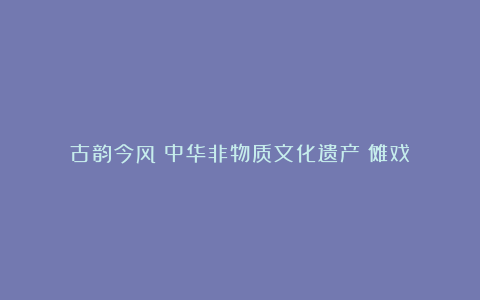傩戏
Nuo Opera
傩戏 作为中国戏曲的古老剧种
承载着数千年的历史文化
不仅是国家级非物质文化遗产
更被誉为“中国戏剧界的活化石”
历史溯源
傩戏起源可追溯至商周时期的方相氏驱傩活动,那时它是古人驱鬼逐疫的巫术仪式。西周时成为固定祭祀活动,人们通过特定仪式祈求平安顺遂。
汉代发展为宫廷傩舞,规模宏大。东汉,傩戏开始向戏剧化演变,融入神话故事,“傩百戏”应运而生,将驱傩与百戏结合。
唐代娱人功能增强,演出规模不断扩大。宋代吸收说唱、歌舞、杂技之长,发展更趋完善。明末清初与戏曲融合,清代流派多样。近现代祭祀性减弱,走向民俗、旅游展示。
It originated from the exorcism of ghosts and witchcraft ceremony in the Shang and Zhou dynasties, and became a fixed sacrifice ceremony in the Western Zhou Dynasty.
The Han Dynasty developed into the palace Nuo dance, and the Eastern Han Dynasty melted into mythology and went into dramatization.
The function of entertaining people in Tang Dynasty was strengthened, and the absorption of various art forms in Song Dynasty became more perfect.
At the end of Ming Dynasty and the beginning of Qing Dynasty, there were various schools in Qing Dynasty. In modern times, the sacrificial nature is weakened, and it is moving towards folk custom and tourism display.
艺术特色
表演形式独特
面具为魂:面具是傩戏艺术造型关键。不同面具代表不同神灵鬼怪,造型夸张独特,能直观展现角色性格。而制作傩面木料特殊,需轻巧坚韧,经多道工序制成 。
– Mask is the soul: mask is the key to Nuo opera artistic modeling. Different masks represent different gods and ghosts, with exaggerated and unique shapes, which can intuitively show the character. Nuo flour production wood is special, light and tough, through a number of processes.
傩技惊人:包含喷水画符、捞油锅、捧炽石、上刀梯、过火海等惊险技艺,充满原始巫术色彩,展示出表演者勇气与神秘仪式感。
– Amazing exorcism skills: including waterspout amulet, oil pan, holding a blazing stone, up a knife ladder, fire and other thrilling skills, full of primitive witchcraft color, showing the performer’s courage and mysterious ritual sense.
宗教融合:演出常与冲傩等宗教活动一体,分 “开坛”“开洞”“闭坛” 三阶段。“开坛” 是请神等宗教仪式;“开洞” 为娱人剧目表演,是核心;“闭坛” 则送神,整个过程祭戏相间。
– Religious integration: The performance is often integrated with religious activities such as Chong-Nuo, and is divided into three stages: ‘opening the altar’, ‘opening a hole’ and ‘closing the altar’. ‘Opening the altar’ is a religious ceremony to invite the gods, etc.; ‘Opening the hole’ is the core of a play to entertain the people; ‘Closing the altar’ is to send the gods, and the whole process of sacrifice alternates with drama.
角色行当丰富
表演者古称巫觋、祭师,被视为沟通神鬼与人的 “通灵” 者。角色分一未、二净、三生、四旦、五丑、六外、七贴旦、八小生等 。民国初年,已有生、旦、净、丑行当记载,且各有细分,如生行含老生、须生、小生、奶生,不同角色表演风格各异。
Performers, known as wizards and priests in ancient times, were regarded as ‘psychics’ who communicated spirits and ghosts with people. The role is divided into one, two clean, three, four Dan, five ugly, six outside, seven stick Dan, eight Xiaosheng and so on. In the early years of the Republic of China, there were records of Sheng, Dan, Jing and ugly trades, and each had its own subdivisions, such as Sheng, Xu Sheng, Xiao Sheng and Niu Sheng, and different roles were performed in different styles.
音乐别具一格

傩戏音乐融合民间歌曲、舞蹈音乐、宗教音乐、说唱音乐、戏曲音乐、器乐等。民间歌曲反映劳动、爱情、历史传说等;舞蹈音乐多为程式化歌舞伴奏,一唱众和;器乐以锣鼓钹等打击乐为主,辅以唢呐等,节奏鲜明,渲染神秘氛围。
Nuo opera music integrates folk songs, dance music, religious music, rap music, opera music, instrumental music and so on. Folk songs reflect labor, love, historical legends, etc.; dance music is mostly accompanied by stylized songs and dances, singing together; instrumental music is mainly percussion music such as gongs, drums and cymbals, supplemented by suona, etc., with distinct rhythm and mysterious atmosphere.
流派纷呈
傩戏流行于安徽、江西、湖北、湖南、四川、贵州、陕西、河北等多地 ,因地域文化差异形成多样流派:
Nuo opera is popular in Anhui, Jiangxi, Hubei, Hunan, Sichuan, Guizhou, Shaanxi, Hebei and other places. Due to regional cultural differences, it has formed various schools:
左右滑动查看更多
池州傩戏
以宗族为单位,春秋祭祀时演出,保留《刘文龙》等古剧目,有 “无傩不成村” 之说。
The clan as a unit, the Spring and Autumn Festival sacrifice performance, the preservation of ‘Liu Wenlong’ and other ancient repertoire, there is ‘no Nuo Village’ said.
恩施傩戏
分 “傩愿戏” 和 “坛傩” ,前者融花鼓戏技巧,后者保留明代祭祖仪式,面具工艺独特。
Divided into ‘Nuo Wishing Opera’ and ‘Tan Nuo’, the former integrates the skills of flower drum opera, the latter retains the ceremony of ancestor worship in Ming Dynasty, and the mask craft is unique.
侗族傩戏
舞蹈以 “三角形” 步伐模拟耕牛动作,剧目融合侗族生活与三国故事。
The dance simulates the action of ploughing cattle with a ‘triangle’ step, and the drama integrates the life of the Dong people and the stories of the Three Kingdoms.
德江傩堂戏
完整保留汉代傩仪传统,表演含复杂法事,是 “中国戏剧活化石”。
The exorcism ceremony tradition of Han Dynasty is preserved completely, and the performance contains complex dharma, which is ‘the living fossil of Chinese drama’.
傩戏是历史 民俗 民间宗教和原始戏剧的综合体
它跨越时空
见证民族文化发展变迁
在新时代
我们应珍视这份珍贵文化遗产
让傩戏继续绽放独特光彩
END
编辑:陶成芸
校审:吴静斐
审核:朱儒进
终审:杨娜